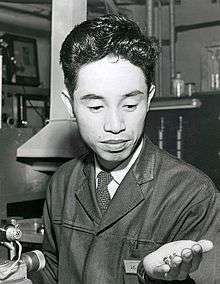Leo Esaki
| Leo Esaki | |
|---|---|
 Leo Esaki in 1959 | |
| Born |
March 12, 1925[1] Osaka, Japan |
| Nationality | Japanese |
| Fields | Applied physics |
| Institutions |
IBM T. J. Watson Research Center Sony University of Tsukuba |
| Alma mater | Tokyo Imperial University |
| Known for |
Electron tunneling Esaki diode Superlattice |
| Notable awards |
Asahi Prize (1959) Japan Academy Prize (1965) Nobel Prize in Physics (1973) IEEE Medal of Honor (1991) Japan Prize (1998)[1] |
| Spouse |
Masako Araki (m.1959-1986) Masako Kondo (m.1986) |
| Children | 3 |
Reona Esaki (江崎 玲於奈 Esaki Reona, born March 12, 1925), also known as Leo Esaki, is a Japanese physicist who shared the Nobel Prize in Physics in 1973 with Ivar Giaever and Brian David Josephson for his discovery of the phenomenon of electron tunneling. He is known for his invention of the Esaki diode, which exploited that phenomenon. This research was done when he was with Tokyo Tsushin Kogyo (now known as Sony). He has also contributed in being a pioneer of the semiconductor superlattices.[1]
Biography
Esaki was born in Osaka and grew up in Kyoto, near by Kyoto Imperial University. He studied physics at Tokyo Imperial University (now the University of Tokyo), where he received his B.Sc. in 1947 and his Ph.D. in 1959.
After Esaki graduated from UTokyo in 1947, he joined Kawanishi Corporation (now Fujitsu Ten) and Tokyo Tsushin Kogyo (now Sony), where he invented Esaki diode. He moved to the United States in 1960 and joined the IBM T. J. Watson Research Center, where he became an IBM Fellow in 1967. His first paper on the semiconductor superlattice[2] was published when he was with IBM. A 1987 comment by Esaki regarding the original paper on superlattices notes:
"The original version of the paper was rejected for publication by Physical Review on the referee's unimaginative assertion that it was 'too speculative' and involved 'no new physics.' However, this proposal was quickly accepted by the Army Research Office..."[3]
In 1973, Esaki was awarded the Nobel Prize[4] for research conducted around 1958 regarding electron tunneling[5] in solids, he became the first Nobel laureate to receive the prize from the hands of the King Carl XVI Gustaf. Esaki moved back to Japan in 1992, subsequently, he served as president of the University of Tsukuba[1] and Shibaura Institute of Technology. Since 2006 he is the president of Yokohama College of Pharmacy. Esaki is also the recipient of The International Center in New York's Award of Excellence, the Order of Culture (1974) and the Grand Cordon of the Order of the Rising Sun (1998).
After the death of Yoichiro Nambu on 2015, Esaki is the eldest Japanese Nobel laureate.
Esaki's “five don’ts” rules
In 1994 Lindau Nobel Laureate Meetings, Esaki suggests a list of “five don’ts” which anyone in realizing his/her creative potential should follow, meanwhile, Carl Nordling just heard the rules and introduce it on Physica Scripta in one year later.:[6]
- Don’t allow yourself to be trapped by your past experiences.
- Don’t allow yourself to become overly attached to any one authority in your field – the great professor, perhaps.
- Don’t hold on to what you don’t need.
- Don’t avoid confrontation.
- Don’t forget your spirit of childhood curiosity.
Awards and honors
- 1959 Asahi Prize
- 1961 Stuart Ballantine Medal
- 1965 Japan Academy Prize
- 1973 Nobel Prize in Physics
- 1974 Order of Culture
- 1989 Harold Pender Award
- 1991 IEEE Medal of Honor
- 1998 Japan Prize
- 1998 Order of the Rising Sun
See also
References
- 1 2 3 4 Dr. Leo Esaki. japanprize.jp
- ↑ Esaki, L.; Tsu, R. (1970). "Superlattice and Negative Differential Conductivity in Semiconductors". IBM Journal of Research and Development. 14: 61. doi:10.1147/rd.141.0061.
- ↑ "This Weeks's Citation Classic", Current Contents No 28, July 13, 1987.
- ↑ Esaki, Leo, "Long Journey into Tunneling," Nobel Lecture, December 12, 1973.
- ↑ Esaki, L. (1958). "New Phenomenon in Narrow Germanium p-n Junctions". Physical Review. 109 (2): 603. Bibcode:1958PhRv..109..603E. doi:10.1103/PhysRev.109.603.
- ↑ 江崎玲於奈『限界への挑戦―私の履歴書』(日本経済新聞出版社)2007年
Further reading
- Large scale integrated circuits technology : state of the art and prospects : proceedings of the NATO Advanced Study Institute on "Large Scale Integrated Circuits Technology: State of the Art and Prospects," Erice, Italy, July 15–27, 1981 / edited by Leo Esaki and Giovanni Soncini (1982)
- Highlights in condensed matter physics and future prospects / edited by Leo Esaki (1991)
External links
| Wikimedia Commons has media related to Leo Esaki. |
- Leo Esaki – Biography. Retrieved August 5, 2003 from http://www.nobel.se/physics/laureates/1973/esaki-bio.html
- IBM record
- IEEE History Center – Leo Esaki. Retrieved July 19, 2011 from http://www.ieeeghn.org/wiki/index.php/Leo_Esaki
- Sony History – The Esaki Diode. Retrieved August 5, 2003 from http://www.sony.net/Fun/SH/1-7/h5.html
- Freeview video 'An Interview with Leo Esaki' by the Vega Science Trust
